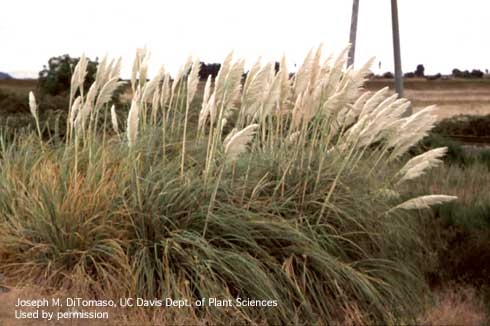Pampasgrass and jubatagrass facts
Pampasgrass (Cortaderia selloana) is a common ornamental landscape plant that readily naturalizes throughout California's coastal areas and some interior regions. Historically, pampasgrass was planted for erosion control, but it has since escaped cultivation and spread along sandy, moist ditch banks throughout coastal regions of southern California. Pampagrass can also grow in the hot, dry climate of inland areas of California.
A similar-looking invasive grass, jubatagrass (Cortaderia jubata) is more widespread and aggressive and is a major pest in coastal redwood forest areas. Jubatagrass thrives in cool, foggy environments and does not tolerate temperature extremes or drought.
Both pampasgrass and jubatagrass outcompete native plants; a single floral plume can make 100,000 seeds in a year. They create fire hazards with excessive build-up of dry leaves, leaf bases, and flowering stalks. The tough leaves have serrated edges that can easily cut skin.
What can you do?
Plant other ornamental grasses in your garden or landscape. Many species including native grasses can be planted that resemble pampasgrass but aren't problematic. This includes several species of Muhlenbergia: deer grass, white awn muhly, and Lindheimer's muhly. California native Pacific reedgrass grows well on the coast and is deer resistant. For a large, tough bunchgrass, try giant sacaton, a native of the Southwest. Giant wildrye, another California native, will grow into dense stands that attract birds.
For more information, see the University of California Weed Research and Information Center fact sheet at https://wric.ucdavis.edu/PDFs/pampasgrass%20and%20jubatagrass%20WRIC%20leaflet%2099-1.pdf
Editor - Associate Director for Urban & Community IPM/ Area Urban IPM Advisor
